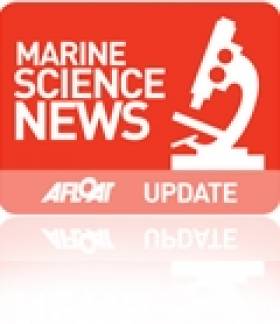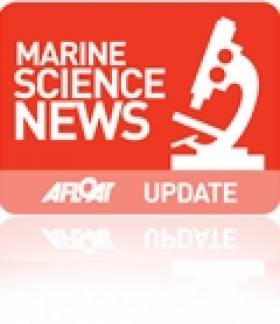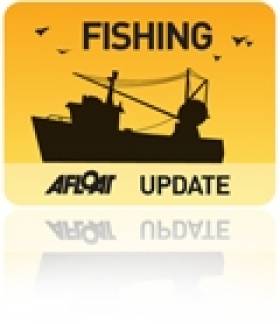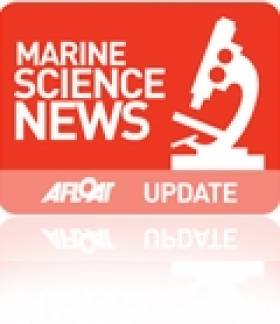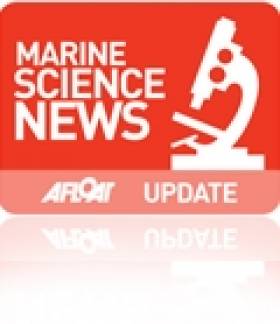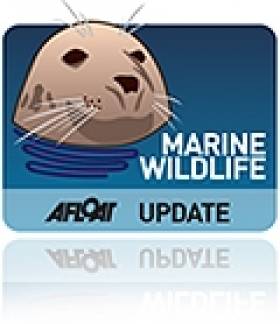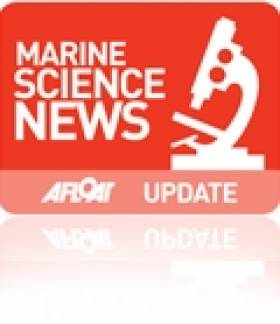Displaying items by tag: marine science
Marine Institute Announces Boost For Seafood Research
#MarineScience - The Marine Institute has secured €800,000 research funding from the Department of Agriculture, Food and the Marine to carry out three significant research projects that address the needs of the aquaculture and seafood industry in the areas of shellfish health and seafood safety.
The funding was announced yesterday (Thursday 1 December) by Marine Minister Simon Coveney as part of the FIRM (Food Institutional Research Measure) competitive research funding programme, and follows the news earlier this month that Ireland's marine researchers won €5.5 million in the latest EU Horizon 2020 funding round in the areas of 'blue growth' and sustainability.
The collaborative projects, which have a total value of €1.2 million, include research partners at NUI Galway, University College Cork and University College Dublin.
The projects will address current challenges in aquaculture and aim to further enhance the health status and food safety standards of farmed Irish shellfish; and ensure compliance with food/feedstuff standards for seaweed.
Dr Peter Heffernan, chief executive of the Marine Institute, welcomed the announcement, saying these projects "will build on the work we are doing in the areas of fish health and seafood safety, together with our research partners.
"We have a strong seafood safety regime in Ireland and these research awards will help to increase our knowledge and further enhance the quality and safety of Irish seafood products."
Dr Heffernan also acknowledged two further research award recipients in NUI Galway and Dublin City University who will focus their research on sustainable aquaculture production systems and mining marine material for novel functional ingredients.
Early in the new year the Marine Institute will seek to fill the three research posts arising from these projects.
Hundreds Of TY Students Visit Marine Institute For Science Fest
#MarineScience - Over 300 Transition Year students from Galway and further afield visited the Marine Institute yesterday (Thursday 20 November) as part of the Galway Science & Technology Festival.
The students met scientists and staff, discovered the wide ranging work of the Marine Institute and got a glimpse of what it would be like to work in marine research.
“We’re delighted to open our doors to students today and we hope they’ll be inspired by the people they meet here and by the work that we’re doing to understand our unique ocean resources," said Marine Institute chief executive Dr Peter Heffernan.
"Some of the students may even go on to become ocean explorers as marine biologists, oceanographers, geographers, mapping the seabed or as engineers, developing novel marine renewable energy devices."
Dr Heffernan also hailed the "many opportunities, particularly with a national and EU focus on the potential of the ‘blue economy’ with the Government plan Harnessing Our Ocean Wealth and the European Commission’s Atlantic Strategy.”
The visit included a talk by Helen McCormick of the Fisheries Ecosystem Advisory Services on the work of the Marine Institute, a 'Sea for Society' video showing the importance of our ocean resource, and an exhibition on marine careers and training opportunities, including the institute's own annual bursar programme for third level students.
Staff and scientists demonstrated their work using touchscreen interactive seabed maps, fish samples and even a mini submarine. They answered well thought-out questions on their work in fisheries science, seabed mapping, seafood safety, oceanography, ocean chemistry and research vessel operations.
For more information on the Galway Science & Technology Festival see www.galwayscience.ie or learn about the Marine Institute at www.marine.ie.
New US Ambassador to Ireland Visits the Marine Institute
#USambassador- The newly appointed US Ambassador to Ireland, Kevin O'Malley met with Dr Peter Heffernan, CEO of the Marine Institute last week at the headquarters of the institute in Oranmore, Co. Galway.
Dr Heffernan highlighted the strong marine transatlantic relationship Ireland has with the USA.
Particular reference was given to the Galway Statement on Atlantic Cooperation that was signed in Oranmore back in 2013 by the USA, Canada and the EU.
The Galway Statement highlighted the effort to align our ocean observation efforts to improve ocean health, stewardship and to promote the sustainable management of its resources.
New Tech Uses Satellite Mapping To Detect Illegal Fishing
#Fishing - Illegal fishing may have just got a little more difficult thanks to a new marine science project backed by Google that aims to map commercial fishing activity around the globe in near real time.
According to The Verge, the Global Fishing Watch system – launched at the IUCN World Parks Congress in Sydney, Australia last week – uses satellite mapping data from SpaceQuest plugged into specialised software from SkyTruth that allows users to track the activity of thousands of fishing boats across the world's oceans.
Wired goes into greater detail on the revolutionary system, which employs complex algorithms to find the most likely patterns of behaviour, from movement to radio usage, that identify a boat as being engaged in fishing.
Using data from 2012 to 2013, the system filtered billions of AIS radio messages sent by over 100,000 ocean-going vessels down to some 25,000 boats that bore the strongest signs of fishing activity - and determined that over 3,000 of those were indeed fishing vessels.
Marine conservation group Oceana, which has led the Global Fishing Watch initiative, says that once the system is ready to handle live data, it will be able to track fishing fleets and individual ships to within a few days – allowing for law enforcement to act if potentially harmful activity is detected.
And the public at large will be able to view the maps in their web browsers, and contribute towards identifying the most likely culprits of illegal fishing.
Wired has much more on the story HERE.
Sampling Of Northwest Herring Spawning Grounds
#Fishing - The Marine Institute intends to obtain samples of spawning herring at the Bills of Achill this month, and the Glen Head/Aranmore area in December.
The samples will be taken during spawning time. These samples are urgently required to assess the extent of mixing of Irish-spawned herring in VIa, particularly VIaN (West of Scotland).
They will be used in a discriminant analysis of herring caught during the summer acoustic survey, taking place West of Scotland and Ireland. The analysis is a matter of urgency because the stocks are subject to a new ICES assessment in 2015.
Currently, herring in VIaN are considered to be part of a separate stock. However preliminary analysis by the Marine Institute suggests a component of herring in VIaN in summer belong to the NW Irish stock.
Authorisation has been received to allow two pairs of pelagic RSW vessels to enter the 12-mile territorial limits, and to fish herring on these known spawning grounds, on one occasion off Mayo and one off Donegal.
The vessels are the FV Olgarry and FV Pacelli, and the FV Felucca and FV Genesis II. These vessels will be fishing against their existing NW herring quotas, and are not being awarded any additional scientific quota for the exercise.
Open Day For TY Students At The Marine Institute
#MarineScience - As part of the Galway Science & Technology Festival 2014, Transition Year students are invited to visit the Marine Institute in Oranmore, Co Galway during a special open day on Thursday 20 November.
TY students will be given a brief introduction to the Marine Institute in its auditorium with a talk about marine science in Ireland.
They will then be invited to meet the Marine Institute's scientists and see their work through a series of exhibitions – including marine environment, fisheries, seafood safety, seabed mapping, research vessel operations and oceanography – as well as getting information and advice on marine careers from the institute's HR team.
These visits will last for about 90 minutes and can be booked in any of three time slots, from 10am till 11.30am, 11.30am till 1pm and 1.30pm till 3pm.
Places are limited and will be booked on a first come, first served basis. Schools are responsible for organising transport. To book a place for your TY students email [email protected].
Marine Institute Brings Underwater TV Survey Tech To Bay Of Biscay
#MarineScience - The first underwater TV (UWTV) survey of the Bay of Biscay Nephrops grounds was carried out on the RV Celtic Voyager from 20-29 September.
This survey involved collaboration between the fishing industry and IFREMER, the French equivalent of the Marine Institute. The Celtic Voyager was chartered for this survey by the French fishing industry (CNPMEM).
The team of French scientists from Lorient were trained in the UWTV survey methodology by Jennifer Doyle, an expert from the Marine Institute. A fishing industry observer also participated in the survey.
This was the furthest south that the Irish Celtic Voyager research vessel has been to at 45°55′N 2°22′W.
The Bay of Biscay Nephrops grounds, known locally as 'la Grande Vasière', have an area of approximately 11,600 sqkm and support landings of Neprophs (better known as Dublin Bay prawns or langoustines) of around 4,000 tonnes annually.
During the 10-day survey, 160 UWTV stations were successfully completed with an average depth of 100 metres. At each station a sled-mounted camera system is towed at 1 knot. This allows for the detailed examination of the sea bed. The Nephrops burrows on the video footage collected are identified and counted by trained and experienced scientists.
Weather conditions throughout were perfect for TV operations with light winds, little or no swell and sea surface temperature around 20 degrees C. The visibility at the seabed was also excellent. The results from this survey will be analysed by IFREMER scientists to determine stock abundance.
The Marine Institute have been developing UWTV survey methods and technology since 2002. Since then, survey coverage has been expanded: in 2014 the main Nephrops stocks fished in Irish waters are have all been fully surveyed – Aran Grounds, Porcupine Bank, Western Irish Sea, Eastern Irish Sea, South Coast, Smalls, Labadie, Jones and Cockburn Banks.
These UWTV surveys form the cornerstone of the ICES assessments and management advice. The results of the TV surveys directly form the basis of the catch options.
All UWTV Marine Institute surveys reports are available online in the Marine Institute's open access repository.
Seabed Mapping Achievements Showcased At INFOMAR Seminar In Waterford
#MarineScience - Seabed mapping activity and developments during 2014 will be showcased at the annual seminar of Ireland’s national marine mapping initiative, INFOMAR, was opened yesterday (Wednesday 22 October) at the Tower Hotel in Waterford.
The INFOMAR programme, dedicated to increasing awareness of Ireland’s marine landscape, carries out hydrographic and geophysical surveys of Irish territorial waters.
It is a co-operative research programme between the Geological Survey of Ireland (GSI) and the Marine Institute (MI) and is funded by the Department of Communications, Energy and Natural Resources.
This ambitious mapping initiative began in 2006, and in its first 10 years will successfully map 26 priority bays and three priority offshore areas.
Using INFOMAR resources, skilled experts based at the GSI and MI develop data products, primarily hydrographic and geological maps that detail the Irish marine territory. These maps are now available for scrutiny HERE.
Minister of State Joe McHugh TD, who was present at the opening, said: “The Government has been strongly supportive of this project, committing €15 million for the five-year period from 2014 to 2018.
"With this continued funding support, Ireland is at the leading edge of European work in marine mapping and in laying the foundations for the sustainable management of our ocean space."
The minster added that “this year a further €3 million is being invested under the INFOMAR project in surveying the gateways to our ports, mapping our fish spawning grounds, finding routes for marine telecommunications cables and selecting the best sites for ocean energy generation. All rely on accurate seabed mapping capability, which Ireland now possesses.”
The 2014 INFOMAR annual seminar will provide an update on progress and plans, and focus on the downstream value and application of the data to underpin development and growth across the marine sector.
New INFOMAR products and services are continuously evolving, and the event will see the launch of a new education programme, a prototype dive tourism mobile app, and INFOMAR Story Maps.
Welcoming the launch, GSI director Koen Verbruggen said that the long-term benefits to Ireland as a result of INFOMAR’s offshore mapping are significant, and include:
- Datasets that feed directly into updated nautical charts via the United Kingdom Hydroghaphic Office.
- Up-to-date advanced mapping facilitates greater awareness of Irish marine opportunities.
- The data are used in planning of protection and development offshore Ireland.
- This project is also highlighting data and knowledge gaps for further exploration and research.
- New international research links have been forged between the surveys and agencies, which is resulting in related projects and employment.
Dr Peter Heffernan, chief executive of the Marine Institute, said: "The Government has prioritised the marine as an area for further growth under the Harnessing Our Ocean Wealth Strategy and the information on Ireland’s vast seabed territory that INFOMAR is capturing and making available will provide a solid platform for sustainable development and growth."
Over 130 attendees are expected to attend the over the day-and-a-half seminar. The work of INFOMAR is also showcased in the latest episode of TV3's maritime documentary series Our Island, broadcast last night and which will be available to stream via the TV3 Player.
See Video Highlights From 'Cetaceans On The Frontier' Voyage
#MarineWildlife - Care of the Irish Whale and Dolphin Group (IWDG), Tony Whelan produced this video documenting some of the highlights of the sixth Cetaceans on the Frontier marine research trip last month.
Researchers boarded the RV Celtic Explorer bound for the European continental shelf on a seven-day trip on which they encountered marine wildlife such as killer whales, pilot whales, dolphins and shearwaters.
The team on this expedition, made possible by the Marine Institute's funded ship time programme, also recovered scientific instruments used to monitor the presence of baleen whales and beaked whales in the area.
A gallery of images from the expedition is available on Facebook HERE.
INFOMAR Develops Transatlantic Co-operation In Seabed Mapping Programme
#MarineScience - George Hanna, a student of the Benthic Acoustic Mapping and Survey (BEAMS) programme in the USA, recently joined the Irish INFOMAR team on the research vessel RV Celtic Voyager during an inshore survey of Mizen Head, Co Cork.
The INFOMAR team provided fieldwork training on board the RV Celtic Voyager using the newly installed EM2040 state-of-the-art multibeam technology to develop detailed maps of the seafloor, as well as a sub-bottom profiler to identify and characterise layers of sediment and rock and surrounding habitat.
Training support is hugely beneficial in developing academic and career opportunities in bathymetric and seafloor habitat mapping on both sides of the Atlantic.
“With the rapid growth of new technologies used in ocean surveying, it is important that undergraduate students get fieldwork experience which focuses on strengthening their skills that can be used in the workforce,” said Thomas Furey, manager of Advanced Mapping Services at the Marine Institute and joint INFOMAR programme manager with the Geological Survey of Ireland.
Collaboration with the College of Charleston and University of Washington’s BEAMS programme came about after focussed development of international INFOMAR industry and research relations in recent years.
This was instigated following the transatlantic co-operation agreement, the 'Galway Statement', signed at the Marine Institute in 2013.
INFOMAR, which hosts its annual seminar in Waterford next week, also supported the nomination of Jay Calvert, University of Ulster, who was recently awarded a Fulbright-Marine Institute Scholarship to attend three months each at Alaska Pacific University in Anchorage, and Northeastern University in Boston.
The BEAMS programme is widely recognised internationally for the output of many academically qualified ocean surveyors, however gaining vessel experience can be challenging.
Volunteering as a survey technician through the programme, George Hanna highlighted the benefits of working with INFOMAR onboard the RV Celtic Voyager, stating: “I was extremely lucky to come to Ireland to get hands on experience on the Voyager and to work with some of the best sonar technology equipment out there.
"Getting real experience during survey operations and deploying numerous ocean-survey related instruments certainly helps support me in expanding my academic opportunities and also getting future work in the area of seabed mapping”.



























